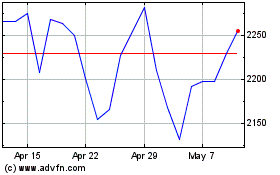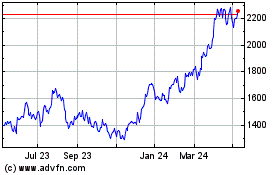UPDATE: Chile's Mining Sector Faces Rising Labor Costs -Antofagasta
March 15 2012 - 6:27PM
Dow Jones News
Cost inflation in the Chilean mining industry is a growing
concern particularly in terms of sourcing skilled labor, said a
senior executive at Chilean miner Antofagasta PLC (ANTO.LN)
Thursday.
"I think labor will be a key driver" in the future, Hussein
Barma, the chief financial officer of Antofagasta's London office,
told an audience at the Jefferies copper conference here.
"There is a big investment pipeline in Chile" that will be
developed over the coming decade, he said. This pipeline is already
driving up the cost of skilled labor. "Competition is high," he
said.
Labor accounts for a little over 10% of Antofagasta's total cost
base, Barma said, and a limited pool of skilled labor is already
having an affect on Antofagasta's operations.
The group's Chief Financial Officer Alejandro Rivera said
Tuesday the U.K.-listed miner is about a month away from completing
negotiations with four contractors that will determine how much it
will cost to develop its $1.3 billion Antucoya copper project in
Chile. The mine will be able to produce 80,000 tons of copper
annually and will start production in the second half of 2014,
Barma said. Although negotiations haven't been finalized yet,
Rivera said the company already expects the project's total capital
cost to rise.
In a similar vein, the limited pool of skilled labor has
prompted Antofagasta to stagger the construction of its Telegrafo
and Caracoles projects in Chile, Barma said. Each project has the
potential to produce as much copper annually as the recently
commissioned Esperanza mine, or 150,000 tons of copper a year, but
the limited labor pool has played a role in Antofagasta decision to
prioritize the construction of Telegrafo and then Caracoles in
order to use one project team to develop both mines, Barma
said.
The Telegrafo project is forecast to start construction in 2014
and copper production in 2017.
"The quality of engineering is a big [issue]," said Barma,
referring to the difficulty in finding skilled labor for
projects.
Barma also said rising costs for energy, sulfuric acid,
explosives and other input material were also putting upward
pressure on mining costs.
He wasn't able to say at what rate costs are likely to rise in
the future but he said cash costs, excluding credits from the sale
of by-products such as gold, have been rising at around an average
of 7% to 10% a year historically.
Water scarcity in Chile is also an issue, he noted. The company
is seeking to address this by pumping sea water to mines such as
Esperanza. While the sea water is basically free, the energy cost
involved in pumping up the water is notable.
Antofagasta has committed about 40 megawatts or a third of its
120 megawatt of power generation capacity to pump sea water 140
kilometers inland and up 2,200 meters to Esperanza, Barma said.
The cost of building that infrastructure was about $300 million
or roughly 10% of the overall capital expenditure for the Esperanza
project, he added.
-By Alex MacDonald, Dow Jones Newswires; +44 (0)20 7842 9328;
alex.macdonald@dowjones.com
Antofagasta (LSE:ANTO)
Historical Stock Chart
From Jun 2024 to Jul 2024

Antofagasta (LSE:ANTO)
Historical Stock Chart
From Jul 2023 to Jul 2024
